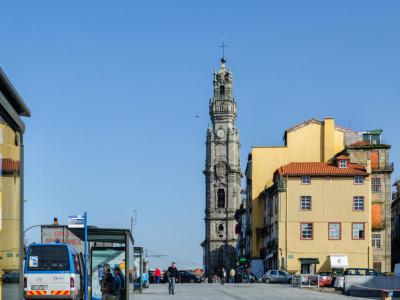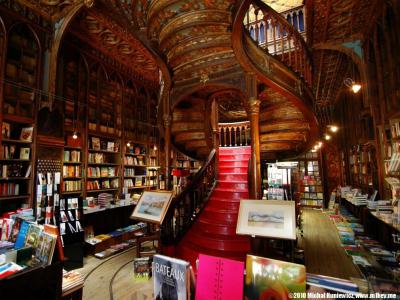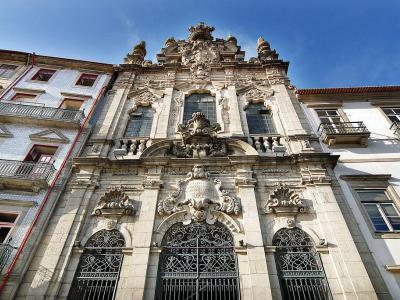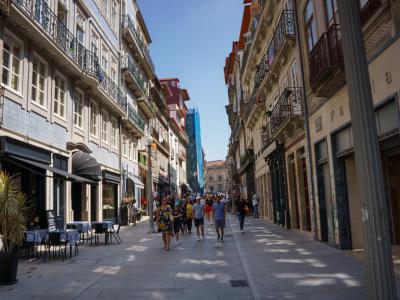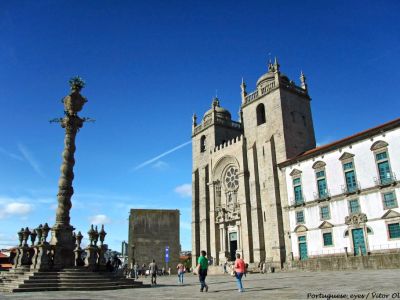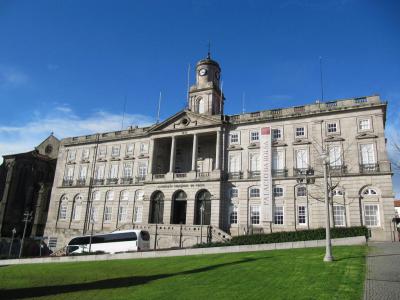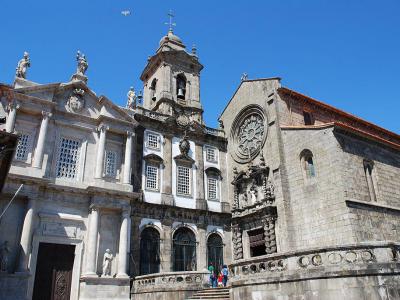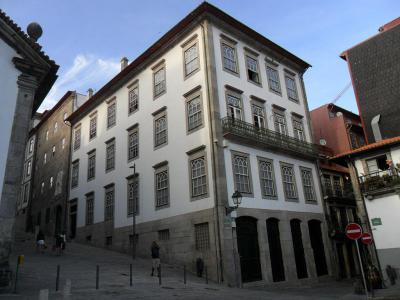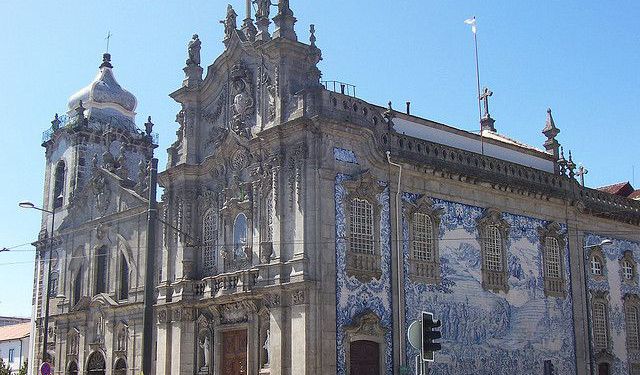Porto Historic Center Walking Tour (Self Guided), Porto
The Historic Centre of Porto, dating back to the Medieval times, is the oldest part of the city and a UNESCO World Heritage Site since 1996. Despite all the changes over the years, it has maintained the unique urban characteristics, which are a world apart from other European cities, and preserved much of its legacy from the times gone by.
Firmly set on the hillsides overlooking the mouth of the River Douro, with its thick flagstones and delicately-moulded façades, Porto’s old quarter, without a doubt, boasts one of Europe’s most astonishing cityscapes. Replete with multiple historic locations, it attracts a fast-growing number of culture-hungry tourists year on year.
Renowned for its unpretentiously charming atmosphere, the historic heart of north Portugal's gracious capital is a warren of narrow, crooked alleyways, worn smooth by countless generations. Here are some of the prominent local sights not to miss:
São Bento Railway Station – integral part of the historic city center; constructed in 1904.
Church and Tower of the Clergymen – one of the most recognizable symbols of Porto, dated from 1750.
Rua das Flores (Flowers Street) – established in the 1520s; now a pedestrian zone, full of beautiful homes with iconic embellishments.
Casa do Infante (Prince Henry's House) – built in the 1300s; believed to be the first home of Prince Henry the Navigator.
Cais da Ribeira (Ribeira Waterfront) – a captivating district of medieval streets and alleys, ending in a busy waterfront square.
Like all ancient cities, historic Porto is best explored on foot. To visit its monuments of incalculable value, in your good time and at your own pace, take this self-guided walk.
Firmly set on the hillsides overlooking the mouth of the River Douro, with its thick flagstones and delicately-moulded façades, Porto’s old quarter, without a doubt, boasts one of Europe’s most astonishing cityscapes. Replete with multiple historic locations, it attracts a fast-growing number of culture-hungry tourists year on year.
Renowned for its unpretentiously charming atmosphere, the historic heart of north Portugal's gracious capital is a warren of narrow, crooked alleyways, worn smooth by countless generations. Here are some of the prominent local sights not to miss:
São Bento Railway Station – integral part of the historic city center; constructed in 1904.
Church and Tower of the Clergymen – one of the most recognizable symbols of Porto, dated from 1750.
Rua das Flores (Flowers Street) – established in the 1520s; now a pedestrian zone, full of beautiful homes with iconic embellishments.
Casa do Infante (Prince Henry's House) – built in the 1300s; believed to be the first home of Prince Henry the Navigator.
Cais da Ribeira (Ribeira Waterfront) – a captivating district of medieval streets and alleys, ending in a busy waterfront square.
Like all ancient cities, historic Porto is best explored on foot. To visit its monuments of incalculable value, in your good time and at your own pace, take this self-guided walk.
How it works: Download the app "GPSmyCity: Walks in 1K+ Cities" from Apple App Store or Google Play Store to your mobile phone or tablet. The app turns your mobile device into a personal tour guide and its built-in GPS navigation functions guide you from one tour stop to next. The app works offline, so no data plan is needed when traveling abroad.
Porto Historic Center Walking Tour Map
Guide Name: Porto Historic Center Walking Tour
Guide Location: Portugal » Porto (See other walking tours in Porto)
Guide Type: Self-guided Walking Tour (Sightseeing)
# of Attractions: 11
Tour Duration: 2 Hour(s)
Travel Distance: 2.6 Km or 1.6 Miles
Author: ChristineS
Sight(s) Featured in This Guide:
Guide Location: Portugal » Porto (See other walking tours in Porto)
Guide Type: Self-guided Walking Tour (Sightseeing)
# of Attractions: 11
Tour Duration: 2 Hour(s)
Travel Distance: 2.6 Km or 1.6 Miles
Author: ChristineS
Sight(s) Featured in This Guide:
- Praça da Liberdade (Liberty Square)
- São Bento Railway Station
- Church and Tower of the Clergymen
- Livraria Lello (Lello Bookstore)
- Igreja da Misericórdia (Church of Mercy)
- Rua das Flores (Flowers Street)
- Sé Catedral do Porto (Porto Cathedral)
- Palácio da Bolsa (Stock Exchange Palace)
- Igreja de São Francisco (St. Francis Church)
- Casa do Infante (Prince Henry's House)
- Cais da Ribeira (Ribeira Waterfront)
1) Praça da Liberdade (Liberty Square) (must see)
In the lower town or Baixa district of Porto, on the south side of the Avenue of the Allies, lies Liberty Square. This is a largish area of more than three square miles. Originally called New Square, Liberty Square is a product of the 1718 urbanization movement of Porto.
In 1788 the religious order of Saint Eligius, Patron Saint of veterinarians, horses, goldsmiths and blacksmiths, built a convent on the south edge of the square. They demolished part of the medieval wall of the city, replacing it with the convent, an impressive neoclassical building, still standing as the Cardosas Palace.
In 1866 a monument honoring King Peter IV was erected in the square. Peter IV was not only King of Portugal as Peter IV, he was also Emperor of Brazil as Peter I.
As each of the two Peters, he fought to preserve the liberal constitution in Portugal and liberty in Brazil. His monument, designed by sculptor Anatole Calmels, is a statue of Peter IV mounted and holding the constitution he had fought for in the Liberal Wars.
The square underwent a change in 1916 when the modern Avenue of the Allies was pushed through to the north of the square. The buildings around the square today are banks, hotels, offices and restaurants. The monument to Peter IV dominates the huge square. Other notable sights would include the Bank of Portugal and the Cardosas Palace.
In 1788 the religious order of Saint Eligius, Patron Saint of veterinarians, horses, goldsmiths and blacksmiths, built a convent on the south edge of the square. They demolished part of the medieval wall of the city, replacing it with the convent, an impressive neoclassical building, still standing as the Cardosas Palace.
In 1866 a monument honoring King Peter IV was erected in the square. Peter IV was not only King of Portugal as Peter IV, he was also Emperor of Brazil as Peter I.
As each of the two Peters, he fought to preserve the liberal constitution in Portugal and liberty in Brazil. His monument, designed by sculptor Anatole Calmels, is a statue of Peter IV mounted and holding the constitution he had fought for in the Liberal Wars.
The square underwent a change in 1916 when the modern Avenue of the Allies was pushed through to the north of the square. The buildings around the square today are banks, hotels, offices and restaurants. The monument to Peter IV dominates the huge square. Other notable sights would include the Bank of Portugal and the Cardosas Palace.
2) São Bento Railway Station
São Bento Railway Station, a 20th-century railway terminal located in the parish of Cedofeita, Porto, stands as a prominent example of Beaux-Arts architecture within the UNESCO World Heritage-listed Historic Centre of Porto. Named after Saint Benedict, the station occupies the site of the former Benedictine Convent of São Bento da Avé Maria, which was demolished in 1892 to make way for this grand transportation hub.
The idea for a central station in Porto began in 1864, but formal plans by José Maria Ferreira and António Júlio Machado, with designs by Hippolyte de Bare, emerged in 1887. Construction started in 1890, with a tunnel finished by 1893, and the first train arrived in 1896. A landslide in 1897 caused delays, but architect José Marques da Silva, inspired by French Beaux-Arts, was hired in 1899. The construction began in 1904, and the station was completed over 13 years.
The station's design is marked by a symmetrical, U-shaped, three-story granite structure with its principal facade facing southwest. The central body, flanked by two volumes, features strong architrave cornices and repetitive geometric patterns. Its robust frame and decorative elements maintain a harmonious balance of form and function, consistent with the Beaux-Arts style.
São Bento is renowned for its extensive azulejo tiles by artist Jorge Colaço, covering 551 square meters with around twenty thousand tiles that depict key moments in Portugal's history and regional traditions. The tiles are framed by pilasters and granite, with friezes illustrating transportation evolution, adding to the station's grandeur. Declared a national monument in 1988, São Bento has been restored since 1992 to preserve its architecture, and part of it now serves as "The Passenger Hostel," blending historic charm with modern use.
The idea for a central station in Porto began in 1864, but formal plans by José Maria Ferreira and António Júlio Machado, with designs by Hippolyte de Bare, emerged in 1887. Construction started in 1890, with a tunnel finished by 1893, and the first train arrived in 1896. A landslide in 1897 caused delays, but architect José Marques da Silva, inspired by French Beaux-Arts, was hired in 1899. The construction began in 1904, and the station was completed over 13 years.
The station's design is marked by a symmetrical, U-shaped, three-story granite structure with its principal facade facing southwest. The central body, flanked by two volumes, features strong architrave cornices and repetitive geometric patterns. Its robust frame and decorative elements maintain a harmonious balance of form and function, consistent with the Beaux-Arts style.
São Bento is renowned for its extensive azulejo tiles by artist Jorge Colaço, covering 551 square meters with around twenty thousand tiles that depict key moments in Portugal's history and regional traditions. The tiles are framed by pilasters and granite, with friezes illustrating transportation evolution, adding to the station's grandeur. Declared a national monument in 1988, São Bento has been restored since 1992 to preserve its architecture, and part of it now serves as "The Passenger Hostel," blending historic charm with modern use.
3) Church and Tower of the Clergymen (must see)
Nicolau Nasoni, an Italian architect and painter of the 18th century, did a lot of work throughout Portugal. His most memorable project is the Church and Tower of the Clergymen. His other works include the construction of the Misericordia Church, the Archbishop's Palace and the lateral loggia of Porto Cathedral.
Construction of the church was completed in 1750. The bell tower and divided staircase in front of the church were not finished until 1763. The facade is ornate with Baroque decorations such as garlands and shells and an indented pediment. The frieze above the windows has spiritual symbols. The sides show an elliptical nave.
The Church of the Clergymen (Clerigos) was among the first baroque style churches to have an elliptical floorplan. The polychromed marble altarpiece in the large chapel was done by Manuel dos Santos Porto.
The Tower is in a Roman Baroque style of Tuscan bell towers. It is 245 feet high and it takes 240 steps to reach the top for an incredible view of Porto. The tower is one of the recognizable symbols of Porto.
Nicolau entered the Clerigos Brotherhood and when he died he was buried in the crypt of his masterpiece, The Church and Tower of the Clergymen.
Construction of the church was completed in 1750. The bell tower and divided staircase in front of the church were not finished until 1763. The facade is ornate with Baroque decorations such as garlands and shells and an indented pediment. The frieze above the windows has spiritual symbols. The sides show an elliptical nave.
The Church of the Clergymen (Clerigos) was among the first baroque style churches to have an elliptical floorplan. The polychromed marble altarpiece in the large chapel was done by Manuel dos Santos Porto.
The Tower is in a Roman Baroque style of Tuscan bell towers. It is 245 feet high and it takes 240 steps to reach the top for an incredible view of Porto. The tower is one of the recognizable symbols of Porto.
Nicolau entered the Clerigos Brotherhood and when he died he was buried in the crypt of his masterpiece, The Church and Tower of the Clergymen.
4) Livraria Lello (Lello Bookstore)
The Livraria Lello is considered to be one of the most beautiful bookstores in the world. It is located in the heart of Porto on the historic Rua dos Clerics. Full of Art Deco elements, visitors to the metropolis will want to spend time exploring this famous structure. The store has been managed by the same company, Lugan & Geneliousx Sucessores, throughout its history.
The Art Deco style is known for its linear and symmetrical elements which drew inspiration from ancient Egypt. The building was first opened in 1906 and contains a fabulous stained glass ceiling, vivid wooden staircase and lavish embellishments. Designed by architect and engineer, Xavier Esteves, the bookstore has been built to withstand the wear and tear of time. The façade of the construction is a combination of Art Nouveau elements and Gothic Revival features. The wooden features, including the shelves are well worth the time to examine.
The shelves reach from floor to ceiling and are covered in phenomenally carved wood. The wooden staircase is filled with the same beautifully carved details. The glass ceiling provides and interesting element and casts warm diffused lighting throughout the entire building.
The Art Deco style is known for its linear and symmetrical elements which drew inspiration from ancient Egypt. The building was first opened in 1906 and contains a fabulous stained glass ceiling, vivid wooden staircase and lavish embellishments. Designed by architect and engineer, Xavier Esteves, the bookstore has been built to withstand the wear and tear of time. The façade of the construction is a combination of Art Nouveau elements and Gothic Revival features. The wooden features, including the shelves are well worth the time to examine.
The shelves reach from floor to ceiling and are covered in phenomenally carved wood. The wooden staircase is filled with the same beautifully carved details. The glass ceiling provides and interesting element and casts warm diffused lighting throughout the entire building.
5) Igreja da Misericórdia (Church of Mercy)
Church of Mercy is a fantastic church that can be found in the center of Porto on the Rua das Flores. It is a very popular attraction with visitors to the metropolis. The structure has a history which begins in the 1500s. Although the building has gone through several renovations over the years, there are still many of the original elements. The façade is reminiscent of the Baroque style of architecture and was added in the 1700s.
Visitors will enjoy exploring the museum inside the building which exhibits many 15th century artworks and artifacts. One, in particular, is the Flemish Fins Vitae that shows King Manuel I and his wife, Leonor, kneeling before the crucifixion. King Manuel I was a 14th-century ruler, under whose reign Portugal became a world power.
The street – Rua das Flores (Flowers Street) – where the structure is located has a history dating back to 1521. It is lined with beautiful homes with wrought iron balconies and iconic embellishments. For those who are fascinated with architecture and design, this street will be well worth setting aside some time to explore.
Tip:
This stunning church is open for only a few hours a day, but you can get to see it as part of your entry to the adjacent museum (10am-6:30pm) that boasts a collection of sacred art.
Visitors will enjoy exploring the museum inside the building which exhibits many 15th century artworks and artifacts. One, in particular, is the Flemish Fins Vitae that shows King Manuel I and his wife, Leonor, kneeling before the crucifixion. King Manuel I was a 14th-century ruler, under whose reign Portugal became a world power.
The street – Rua das Flores (Flowers Street) – where the structure is located has a history dating back to 1521. It is lined with beautiful homes with wrought iron balconies and iconic embellishments. For those who are fascinated with architecture and design, this street will be well worth setting aside some time to explore.
Tip:
This stunning church is open for only a few hours a day, but you can get to see it as part of your entry to the adjacent museum (10am-6:30pm) that boasts a collection of sacred art.
6) Rua das Flores (Flowers Street)
Vegetable and lush flower gardens gave this street its name. In fact, the land used for the street was originally the gardens of Pedro Alvarez da Costa, Bishop of Porto. He was devoted to Saint Catherine of Mount Sinai. The initial name for the street was "Saint Catherine Flowers Street", opened in 1525 in the reign of King Manuel.
With the construction of the street came the end of prohibitions of Nobility settling in the city and the rise of the bourgeoisie. Flowers Street was a host to these historic developments. Exact regulations arose regarding the type of housing permitted. The fronts on the street were standardized, ensuring clear visibility of facades.
There was some urban aristocracy, but most of the street housed tradespeople. There were mechanics, cobblers, metalworkers, bricklayers and blacksmiths. There was a demand for skilled artisans to build for the developing middle class.
Today, the street is still in fashion. It is a pedestrianized zone, ideal for casual walking and sight seeing.
With the construction of the street came the end of prohibitions of Nobility settling in the city and the rise of the bourgeoisie. Flowers Street was a host to these historic developments. Exact regulations arose regarding the type of housing permitted. The fronts on the street were standardized, ensuring clear visibility of facades.
There was some urban aristocracy, but most of the street housed tradespeople. There were mechanics, cobblers, metalworkers, bricklayers and blacksmiths. There was a demand for skilled artisans to build for the developing middle class.
Today, the street is still in fashion. It is a pedestrianized zone, ideal for casual walking and sight seeing.
7) Sé Catedral do Porto (Porto Cathedral) (must see)
In 868, Vimara Peres, an Asturias nobleman born in 820, conquered Moorish held lands north of the river Douro. One of the towns he took went by the name Portus Cale. Portus Cale became Portucale, the county he would rule. The town became Porto. Penaventosa, the highest hill in Portus Cale, became the site of Porto Cathedral.
The hill was once the location of a Suebian Church. Work began on the Cathedral in the 12th century. There were fits and starts over the years, but the building was finally considered complete in 1737. It is the most impressive Romanesque style edifice in Porto. On top of Penaventosa it sits, fortress-like, overlooking the town.
The cathedral is flanked by twin square towers. Each tower is buttressed and topped with a cupola. The western façade has 15th century Gothic ornamentation. There is also an impressive Gothic cloister installed in 1736 by Nicolau Nasoni, an architect from Tuscany who settled in Portugal.
On the northern side of the cathedral is a baroque porch and a Romanesque rose window under a crenelated arch. The crenellations reinforce the impression of a fortress. The nave is not wide. It is covered with a barrel vault.
The baroque apse is decorated with paintings by Nasoni. The altarpiece of the chapel was designed by Santos Pacheco. The south transept is decorated with blue azulejo tiles.
Mass is celebrated every day at 11am.
Why You Should Visit:
You wouldn't want to miss the city's oldest and most visited monument! The square also offers impressive views over the city, the Douro River and the wine cellars on the waterfront.
Tip:
While admission to the Porto Cathedral is free, there's a small fee to get into the Sacred Art Museum and the magnificent Gothic cloisters attached to the church. If you're feeling fit you can also climb the tower (steps are steep and numerous!) for amazing views, including at the bits of the cathedral you can't see from further down.
The hill was once the location of a Suebian Church. Work began on the Cathedral in the 12th century. There were fits and starts over the years, but the building was finally considered complete in 1737. It is the most impressive Romanesque style edifice in Porto. On top of Penaventosa it sits, fortress-like, overlooking the town.
The cathedral is flanked by twin square towers. Each tower is buttressed and topped with a cupola. The western façade has 15th century Gothic ornamentation. There is also an impressive Gothic cloister installed in 1736 by Nicolau Nasoni, an architect from Tuscany who settled in Portugal.
On the northern side of the cathedral is a baroque porch and a Romanesque rose window under a crenelated arch. The crenellations reinforce the impression of a fortress. The nave is not wide. It is covered with a barrel vault.
The baroque apse is decorated with paintings by Nasoni. The altarpiece of the chapel was designed by Santos Pacheco. The south transept is decorated with blue azulejo tiles.
Mass is celebrated every day at 11am.
Why You Should Visit:
You wouldn't want to miss the city's oldest and most visited monument! The square also offers impressive views over the city, the Douro River and the wine cellars on the waterfront.
Tip:
While admission to the Porto Cathedral is free, there's a small fee to get into the Sacred Art Museum and the magnificent Gothic cloisters attached to the church. If you're feeling fit you can also climb the tower (steps are steep and numerous!) for amazing views, including at the bits of the cathedral you can't see from further down.
8) Palácio da Bolsa (Stock Exchange Palace) (must see)
The cloisters of Saint Francis Convent were burnt during the Liberal wars in 1832. In 1841 Queen Mary II donated the ruins to the merchants of Porto. They used the site to build the new Commercial Association. Architect Joaquim da Costa Lima Junior designed a Palladian neoclassical palace that harmonized with previous structures of the city.
The Palace was generally completed by 1850 but details which include the staircase and the Arab Room, courtyard dome, and Tribunal were later added.
The octagonal dome has glass panels and the coats-of-arms of Portugal and the countries trading with Portugal in the 19th century. In the rear of the courtyard is a sumptuous stairway, lined with busts by famous sculptors.
The star of the show however, is the Arab Room. Done in the Moorish Revival style, it is used primarily for receptions for visiting heads of state.
The Stock Exchange Palace is located in the Infante D. Henrique Square in the center of Porto.
Why You Should Visit:
The guided tour takes you through many of the exquisitely decorated rooms of this amazing building. Some are a little over-the-top but they are really something to see, each decorated in a completely unique way.
Tip:
The Palace can only be visited on a guided tour. Upon arrival, there's a computerized screen telling you which tours in which languages are available. The guided tour lasts approximately 45 minutes.
The Palace was generally completed by 1850 but details which include the staircase and the Arab Room, courtyard dome, and Tribunal were later added.
The octagonal dome has glass panels and the coats-of-arms of Portugal and the countries trading with Portugal in the 19th century. In the rear of the courtyard is a sumptuous stairway, lined with busts by famous sculptors.
The star of the show however, is the Arab Room. Done in the Moorish Revival style, it is used primarily for receptions for visiting heads of state.
The Stock Exchange Palace is located in the Infante D. Henrique Square in the center of Porto.
Why You Should Visit:
The guided tour takes you through many of the exquisitely decorated rooms of this amazing building. Some are a little over-the-top but they are really something to see, each decorated in a completely unique way.
Tip:
The Palace can only be visited on a guided tour. Upon arrival, there's a computerized screen telling you which tours in which languages are available. The guided tour lasts approximately 45 minutes.
9) Igreja de São Francisco (St. Francis Church) (must see)
In 1244 the bishop of Porto didn't like the Franciscans. Other religious orders and clergy didn't mind pushing them around. What was needed was a papal bull and they got one from Pope Innocent V. He chided the bishop and returned to the Franciscans the land the bishop had taken from them. The monks then built a convent and church.
The Franciscans had their foot in the door and in 1383, with the patronage of King Ferdinand I, they built a bigger church. The church was complete in 1425. It was done in the plain Gothic style favored by mendicant orders of the time. To this day the Franciscan church is the best example the Gothic style in Porto.
In the 15th and 16th centuries socially prominent families made the Church of Saint Francis theirs. The Chapel of John the Baptist, for example, was built in the 1530s for the Carneiro family in the Manueline style. In the 18th century the interior surfaces were covered with gilt work in a Baroque style, including the apses and nave.
During the siege of Porto in 1832 the cloisters were destroyed. The Commercial Association built the Stock Exchange Palace in its place.
Why You Should Visit:
If you like seeing countless hours of opulent, very ornate wood carving covered in gold leaf, then this is the place for you.
Tip:
Don't miss the little museum and the catacombs that are included in the ticket price.
The Franciscans had their foot in the door and in 1383, with the patronage of King Ferdinand I, they built a bigger church. The church was complete in 1425. It was done in the plain Gothic style favored by mendicant orders of the time. To this day the Franciscan church is the best example the Gothic style in Porto.
In the 15th and 16th centuries socially prominent families made the Church of Saint Francis theirs. The Chapel of John the Baptist, for example, was built in the 1530s for the Carneiro family in the Manueline style. In the 18th century the interior surfaces were covered with gilt work in a Baroque style, including the apses and nave.
During the siege of Porto in 1832 the cloisters were destroyed. The Commercial Association built the Stock Exchange Palace in its place.
Why You Should Visit:
If you like seeing countless hours of opulent, very ornate wood carving covered in gold leaf, then this is the place for you.
Tip:
Don't miss the little museum and the catacombs that are included in the ticket price.
10) Casa do Infante (Prince Henry's House)
Prince Henry's House, also known as the Old Customshouse, is a historical landmark in Porto. Originally constructed in the 14th century, this building served as a customs house and mint, with most of its current form resulting from a significant 17th-century renovation. The name House of the Prince stems from a local tradition that claims it was the birthplace of Prince Henry the Navigator in 1394, making it a site of notable historical interest in Porto’s UNESCO-designated World Heritage Center.
The original customshouse was built in 1325 by royal decree on the remnants of a Roman villa and was operational by 1327. In 1354, during King D. Afonso IV's reign, the construction of a new medieval customshouse began as part of a conflict between the king and the Bishop of Porto over the taxation of goods on the Douro River. Located near the riverbank, this structure not only minted coins but also functioned as a warehouse and residential space for employees.
The architectural layout features four interconnected rectangular spaces with different ceiling tiles. The facade has four stories of canopy windows, a large arched doorway with the royal coat of arms, and a 1677 inscription. Inside, a framed patio with archways connects to the upper floors and eastern sections. The main interior space is divided into three naves by high arcades, with two stories accessible via a central staircase. The rear facade's high windows illuminate the pavement and patio, linking the eastern and northern buildings. Access to Rua Infante D. Henrique is via a ramp and tunnel leading to an archway with the royal coat of arms, near a stone bearing the Avis family shield.
Over the years, the building has been remodeled many times to fit the needs of new inhabitants, which in turn makes it an interesting mixture of architectural styles. More recently, it has been the focus of archaeological research which has revealed Roman foundations along with the incredible mosaics currently displayed at the museum, which features interactive displays in both Portuguese and English.
Why You Should Visit:
Compact but informative museum; gives a good insight into the building itself, which was used as a Customs House and coin mint, and also the growth and development of the city of Porto from Roman times onwards. A lot of the exhibits seem very new, with some audiovisual and interactive displays. The entry fee is very reasonable!
The original customshouse was built in 1325 by royal decree on the remnants of a Roman villa and was operational by 1327. In 1354, during King D. Afonso IV's reign, the construction of a new medieval customshouse began as part of a conflict between the king and the Bishop of Porto over the taxation of goods on the Douro River. Located near the riverbank, this structure not only minted coins but also functioned as a warehouse and residential space for employees.
The architectural layout features four interconnected rectangular spaces with different ceiling tiles. The facade has four stories of canopy windows, a large arched doorway with the royal coat of arms, and a 1677 inscription. Inside, a framed patio with archways connects to the upper floors and eastern sections. The main interior space is divided into three naves by high arcades, with two stories accessible via a central staircase. The rear facade's high windows illuminate the pavement and patio, linking the eastern and northern buildings. Access to Rua Infante D. Henrique is via a ramp and tunnel leading to an archway with the royal coat of arms, near a stone bearing the Avis family shield.
Over the years, the building has been remodeled many times to fit the needs of new inhabitants, which in turn makes it an interesting mixture of architectural styles. More recently, it has been the focus of archaeological research which has revealed Roman foundations along with the incredible mosaics currently displayed at the museum, which features interactive displays in both Portuguese and English.
Why You Should Visit:
Compact but informative museum; gives a good insight into the building itself, which was used as a Customs House and coin mint, and also the growth and development of the city of Porto from Roman times onwards. A lot of the exhibits seem very new, with some audiovisual and interactive displays. The entry fee is very reasonable!
11) Cais da Ribeira (Ribeira Waterfront) (must see)
The origins of the settlement along the Ribeira is not really known. A riverside settlement developed near the confluence of the Vila River and the Douro River. Some Roman mosaics from the fourth century have been found in the area. The Ribeira grew along with Porto in the 13th century. Especially by the river and Penaventosa hill.
Two settlements arose. One on the escarpment of Penaventosa by Porto Cathedral. The other appeared below in Ribiera on the banks of the Douro River. Until the last decade of the 14th century the settlements were connected by a web of narrow, constricting streets difficult to move around in. A new street was needed to pierce the labyrinth.
On the initiative of John I a new street was opened. In fact, it was called "New Street" (Rua Nova). It was a perfect contrast to the tangled web of passageways of Porto. It was straight, and wide for its time. It became a prestigious address for the bourgeoisie, clergy and business.
The Ribeira district lures the visitor on. It is a captivating place of medieval streets and alleys ending in a busy waterfront square, the Ribeira Square. The remains of the 14th century wall run next to the Ribeira Wharf. Beyond this point are the steep twisted ways of the Barredo.
In the evenings clubs on the Ribeira Wharf promise a stimulating nightlife to romantic strollers. In days gone by the district alongside the Douro River was a center of lively commerce and business.
The Ribeira Square has many shops and cafes. At the northern part of the square is a huge fountain. The Ribeira Wharf starts on the west side of the Luis I Bridge and it follows the riverside to Ribeira Square.
There is an upper walkway where there are more shops and cafes. The walkway is what is left of the old city walls, once patrolled by medieval soldiers on watch. Sit down, have a drink and watch the river with them. Time glides by like the river.
Two settlements arose. One on the escarpment of Penaventosa by Porto Cathedral. The other appeared below in Ribiera on the banks of the Douro River. Until the last decade of the 14th century the settlements were connected by a web of narrow, constricting streets difficult to move around in. A new street was needed to pierce the labyrinth.
On the initiative of John I a new street was opened. In fact, it was called "New Street" (Rua Nova). It was a perfect contrast to the tangled web of passageways of Porto. It was straight, and wide for its time. It became a prestigious address for the bourgeoisie, clergy and business.
The Ribeira district lures the visitor on. It is a captivating place of medieval streets and alleys ending in a busy waterfront square, the Ribeira Square. The remains of the 14th century wall run next to the Ribeira Wharf. Beyond this point are the steep twisted ways of the Barredo.
In the evenings clubs on the Ribeira Wharf promise a stimulating nightlife to romantic strollers. In days gone by the district alongside the Douro River was a center of lively commerce and business.
The Ribeira Square has many shops and cafes. At the northern part of the square is a huge fountain. The Ribeira Wharf starts on the west side of the Luis I Bridge and it follows the riverside to Ribeira Square.
There is an upper walkway where there are more shops and cafes. The walkway is what is left of the old city walls, once patrolled by medieval soldiers on watch. Sit down, have a drink and watch the river with them. Time glides by like the river.
Walking Tours in Porto, Portugal
Create Your Own Walk in Porto
Creating your own self-guided walk in Porto is easy and fun. Choose the city attractions that you want to see and a walk route map will be created just for you. You can even set your hotel as the start point of the walk.
Porto's Monuments and Statues
In general, just like any other European nation, sunny Portugal is rich in history and matching love of monuments. This is more so evident in the country's second largest city of Porto, dotted with statues and sculptures of various sort, decorating the gardens, sidewalks, squares and various corners. Each of them has its own story; some are quite old, while others are not so much and rather... view more
Tour Duration: 1 Hour(s)
Travel Distance: 2.1 Km or 1.3 Miles
Tour Duration: 1 Hour(s)
Travel Distance: 2.1 Km or 1.3 Miles
Shopping and Food Tour
Renowned for its centuries-old culture and architecture, Porto also boasts a wealth of shopping and dining opportunities. With a mix of the modern and historical, the city represents a fertile ground for bargain hunters, foodies and luxury-seekers alike.
Those on the look-out for trendy clothing and accessories, or wanting to sample some delicious local cuisine, will certainly not be... view more
Tour Duration: 1 Hour(s)
Travel Distance: 1.6 Km or 1 Miles
Those on the look-out for trendy clothing and accessories, or wanting to sample some delicious local cuisine, will certainly not be... view more
Tour Duration: 1 Hour(s)
Travel Distance: 1.6 Km or 1 Miles
Historical Churches
Portugal is one of the oldest countries in Europe and is deeply rooted in Christianity, notably Catholicism. The latter explains the abundance of historic chapels, churches, and monasteries in the country. Porto, a city with a rich historical and cultural heritage, boasts several old churches of its own. Remarkable architectural gems, they reflect the city's profound religious tradition.
... view more
Tour Duration: 2 Hour(s)
Travel Distance: 3.9 Km or 2.4 Miles
... view more
Tour Duration: 2 Hour(s)
Travel Distance: 3.9 Km or 2.4 Miles
Porto Introduction Walking Tour
After 711 Porto fell to Moorish invaders. The Muslim control existed in the Iberian peninsula until 1491. However, the conquest was not total and in 868 things began to change for the people of Porto.
Vimara Peres, an Asturian count of Gallaecia, came to reconquer for the Christians. He secured the town of Portu Cale and the land of Vila Nova de Gaia. Vimara became the Count of Portucale. From... view more
Tour Duration: 2 Hour(s)
Travel Distance: 3.2 Km or 2 Miles
Vimara Peres, an Asturian count of Gallaecia, came to reconquer for the Christians. He secured the town of Portu Cale and the land of Vila Nova de Gaia. Vimara became the Count of Portucale. From... view more
Tour Duration: 2 Hour(s)
Travel Distance: 3.2 Km or 2 Miles
The Most Popular Cities
/ view all





